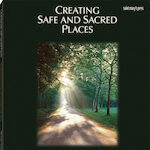Creating Safe and Sacred Places
Identifying, Preventing, and Healing Sexual Abuse
Overview
Your ministry with young people begins by building relationships that include appropriate boundaries. Creating Safe and Sacred Places is the first resource of its kind in response to The Charter for the Protection of Children and Youth (issued by the United States Catholic Conference of Bishops). The charter calls, in part, for dioceses, schools, and parishes to establish "safe environment" programs. Creating Safe and Sacred Places is written by an expert in the field of sexual abuse and by a veteran youth minister. The manual provides information on procedures and strategies to promote a safe environment, including material for training parents, ministers, educators, and church personnel in identifying, preventing, and healing sexual abuse.
Product Details
Copyright: Sept. 8, 2003
Format: Paperback
Size: 8.5 x 11
Length: 160 pages
Weight: 1.000lbs
Item number: 3328
ISBN: 978-0-88489-809-2
ISBN-10: 0-88489-809-1
Customer Reviews
By Jack Podsiadio, SJ, executive director, Nativity Educational Centers Network
By Laura L. Rogers, Esq., child abuse prosecutor, National Center for Prosecution of Child Abuse
By David Finkelhor, director of Crimes Against Children Research Center, University of New Hampshire, and author of numerous books, including A Sourcebook on Child Sexual Abuse and Sexually Victimized Children
By Robert J. McCarty, executive director, National Federation for Catholic Youth Ministry
Editorial Reviews
Momentum, February/March, 2004
The manual begins with an overview, explaining the stages of sexual abuse, warning signs, indicators of healthy sexual development, signs and long-term effects of abuse. This section will provide important information for the nonspecialist and a useful and concise summary for people familiar with this area.
The next section on sexual abuse in the church will be helpful to church workers because it provides theological and historical background information, with a discussion of the problems related to secrecy and the mishandling of sexual abuse issues in the church. . . .
The authors then allow a survivor of sexual abuse to tell her story. . . . Like so much of this manual, it manages to deal with a difficult and painful topic without loosing sight of hope and healing. My first response was one of surprise, "Why didn't they ask a survivor of clerical sexual abuse to contribute to this chapter?" However, on reflection, their decision is a wise one. The majority of sexual abuse that is encountered in our parishes is by members of children's families. It is important to be reminded of this fact and not allow the shock of the revelations of the past years to obscure this painful fact.
The third section of the book is devoted to outlines of sessions to educate, prevent and heal sexual abuse. The authors continually recommend a team approach to this work and speak of the necessity for a community approach. . . . The guidelines are clear, and there is a range of creative activities to help in creating safe and sacred space for this important task. Again, given the difficulties of dual responsibilities, the authors suggest strongly that it is better that these sessions not be led by clergy, and that skilled professionals be part of the team, or at the very least, available for advice and help.
As I reached the end of the manual, I was struck by a number of things. Despite the hurt and pain associated with this topic, the book manages to be positive. Those who use this book will be grateful for the clarity of writing; the practical and sensitive sessions; the way that prayer, spirituality and values are integrated into the text; the wise advice based on pastoral and clinical experience; and the commitment to education, communication, healing and prevention. This book will be welcomed by those responsible for raising awareness of this topic and should find its way into the offices of priests, educators and pastoral workers. Like the attractive photograph on its cover, this book has the potential to bring light to some dark places.
Review by Brendan Geary, FMS
Review by Timothy Dwyer, assistant executive director, Chief Administrators of Catholic Education, National Catholic Educational Association




